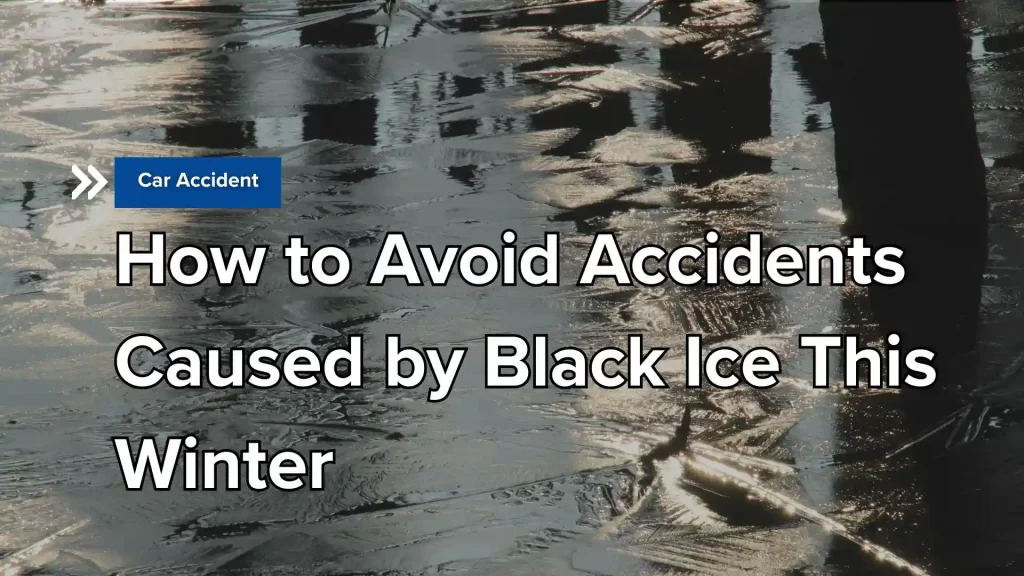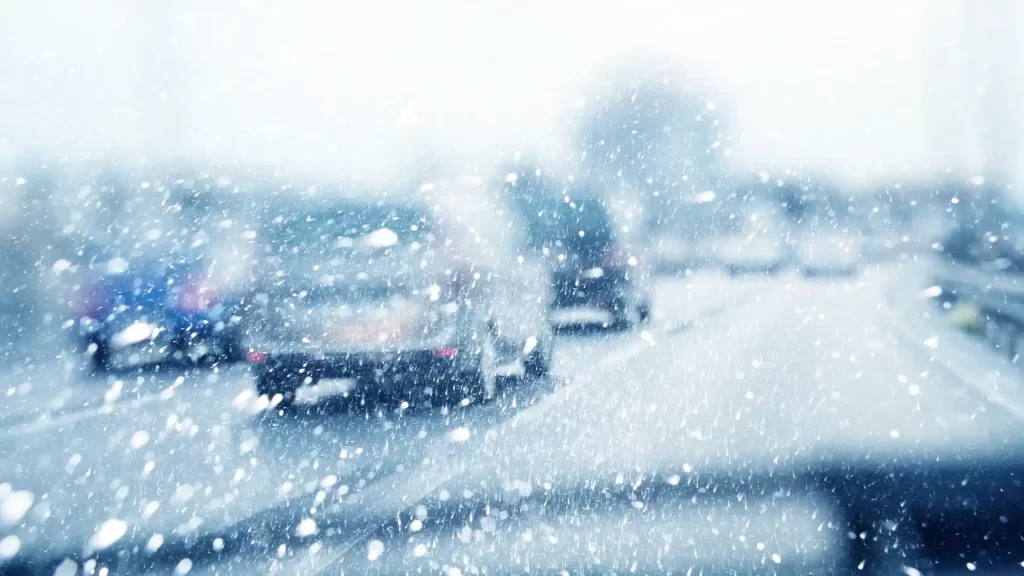
Black ice is a hidden winter danger, causing many accidents each year, including those accidents caused by black ice. It forms when moisture freezes on cold roads, making them nearly invisible and extremely slippery. Understanding how black ice leads to accidents and how to avoid them is essential for safe winter driving. This article offers insights into recognizing black ice, adjusting your driving, and staying safe on icy roads affected by accidents caused by black ice.
Understanding Black Ice and Its Formation
Black ice presents a serious winter hazard that drivers must understand to avoid potentially life-threatening situations. This nearly invisible, slippery ice layer blends seamlessly with pavement, making it extremely dangerous. Gaining knowledge about the formation and typical locations of black ice can greatly enhance your road safety.
When is black ice likely to occur on the road? Black ice forms when light precipitation lands on surfaces at or below freezing temperatures, causing the moisture to freeze. This cold air phenomenon is commonly observed on bridges, overpasses, shaded areas, and snow-covered roads.
Freezing temperatures cause any existing moisture on the road, such as melted snow or condensation, to refreeze and form black ice. This process is particularly common during the early morning hours when temperatures drop rapidly, making it essential for drivers to be extra cautious during winter weather.
Common Locations for Black Ice
Some areas more prone to black ice include bridges, overpasses, shaded areas and those under buildings or trees.
Roadways near bodies of water, like lakes or rivers, are additional hotspots for black ice due to the high moisture content in the air. Being aware of these common locations can help you anticipate and avoid black ice patches, thus reducing the risk of accidents.
Recognizing Warning Signs of Black Ice
Be aware of black ice forming, especially in the early morning when temperatures drop. Look for glossy patches of black ice on the road, monitor the weather, and keep a safe distance from other vehicles.
Visual Indicators
One of the most telling visual indicators of black ice is its shiny appearance on the road. If most of the road has a dull black color but there’s a patch ahead that appears shiny, you may be approaching black ice. This is especially noticeable when using headlights during the afternoon and evening.
Black ice is almost perfectly clear with no trapped air bubbles or swirls, making it blend in with the pavement. Always be on the lookout for these shiny spots, as they can be a sign of a dangerous black ice patch.
Environmental Cues
Keep an eye on freezing temperatures, especially during the early morning. Drive cautiously on bridges, overpasses, and shaded areas to avoid hitting black ice patches. Monitor your car’s thermometer and stay informed through weather reports to avoid dangerous icy road conditions.
Driving Behavior Adjustments
Remember: While driving in black ice conditions, adjust your driving behavior by driving slowly and avoiding cruise control for better vehicle control.
If you do encounter black ice, remove your foot from the gas pedal and refrain from pressing the brake. Keeping the steering wheel straight until traction is regained can help manage sliding and prevent further loss of control.
Preventive Measures for Drivers
Is black ice dangerous? It depends on the speed of your driving and how risky other cars are driving. Taking preventive steps is fundamental to secure safety on icy roads. Winter driving demands a more proactive approach due to reduced traction and unpredictable conditions. Proper vehicle maintenance, safe driving practices, and emergency preparedness can significantly reduce the risk of accidents.
Maintaining a safe distance from other vehicles on icy roads is essential for minimizing the likelihood of collisions. Further sections will elaborate on vehicle upkeep, safety-oriented driving habits, and readiness for emergencies. According to the Minnesota Department of Transportation, these are the measures you should take:
Vehicle Maintenance
Proper vehicle maintenance is key to preventing black ice accidents. Cold weather causes tire pressure to drop, so regularly check and maintain the recommended tire pressure. Also, make sure your windshield wiper blades are in good condition for clear visibility during snowy or icy conditions.
Using freeze-resistant wiper fluid can prevent the buildup of ice, snow, salt, and mud on your windshield. Regularly inspecting and maintaining these aspects of your vehicle will enhance your safety on black ice-prone roads.
Safe Driving Practices
Adopting safe driving practices is essential for handling icy roads. Reducing speed allows for more time to react and better control. The stopping distance on black ice can be nine times longer than on a dry road, so increasing your following distance is essential.
Avoiding sudden movements like abrupt turns, braking, or acceleration helps maintain vehicle control and prevent a car slide. Gradual and smooth steering can prevent skidding and safer travel on icy surfaces.
Emergency Preparedness
Being prepared for emergencies is essential during winter driving. An emergency kit should include items such as:
- an ice scraper
- jumper cables
- flashlight
- batteries
- warm clothing
- blankets
- a shovel
- kitty litter or sand for traction
- a first-aid kit
- non-perishable snacks and water
In case your vehicle gets stuck in the snow and ice, here are some tips to help you out:
- Use emergency flashers to alert other drivers
- Make sure the exhaust pipe is clear to prevent carbon monoxide buildup
- Have kitty litter or sand on hand to provide traction and help get your vehicle moving again
- If you lose control and begin to skid, remember to steer into the skid and lift your foot off the accelerator.
Legal Implications of Accidents Caused by Black Ice
Black ice accidents can have serious legal consequences. Drivers need to adjust their driving to changing weather conditions to stay safe. Even in bad weather, drivers can be at fault for accidents if found negligent. Drivers can be at fault for accidents on icy roads, and property owners can be liable for injuries caused by black ice.
Determining Fault
Determining fault in black ice accidents involves investigating whether the driver acted negligently or failed to adapt to conditions. Liability can sometimes be shared with third parties if roads weren’t properly maintained.
While drivers must exercise due caution, they may not always be held solely liable due to the presence of black ice. Thorough investigations are often required to determine the extent of negligence and any contributing factors.
Multi-Car Collisions
Multi-car collisions on icy roads make determining fault challenging due to chain reaction collisions. A thorough investigation of each driver’s actions is necessary to assign liability.
In multi-car accidents, determining fault can be complex. Drivers should provide detailed accounts of their actions and cooperate with authorities for a fair assessment of liability.
Steps to Take After an Accident
If you find yourself in an accident caused by black ice, there are essential steps you should follow. First, stay calm and contact authorities promptly to report the incident. Document the scene with photos and notes to have accurate records of what happened.
Exchange information with the other parties involved, including names, contact details, and insurance information. Seek medical attention if you are hurt. Avoid admitting fault and consult with a lawyer before talking to the other parties’ insurance companies.
Role of Road Maintenance in Preventing Black Ice Accidents

Road maintenance professionals play a critical role in preventing accidents related to black ice by using pre-treatment strategies, real-time monitoring, and post-incident responses to keep roads safe during winter.
Upcoming sections will delve into various facets of road maintenance such as pre-treatment strategies, real-time surveillance, and response post-incident, emphasizing their contribution in preventing black ice accidents.
Pre-Treatment Strategies
Municipalities use anti-icing agents like brine solutions and calcium chloride to prevent the formation of black ice on roadways before a storm hits.
Anti-icing treatments can be applied a few hours to up to three days before a winter storm begins. Using less corrosive alternatives like calcium-magnesium acetate can also help protect road surfaces and vehicles while being environmentally friendly.
Real-Time Monitoring
Real-time monitoring of weather and pavement conditions is essential for effective winter road maintenance. Infrared temperature sensors on vehicles measure road surface temperatures to detect black ice and assess wet road conditions.
Systems like ClearPath Weather® provide powerful weather and pavement insights, risk management tools, and route-specific treatment recommendations, enabling maintenance teams to respond swiftly to changing conditions.
Post-Incident Response
Post-incident response is essential for restoring road safety after black ice has formed. Timely application of salt and sand can improve traction and prevent further accidents.
Deploying emergency response teams quickly to affected areas makes sure that roads are treated promptly, reducing the risk of additional incidents.
Contact a Chicago Car Accident Lawyer
Understanding and preventing black ice accidents is essential for safe winter driving. At JJ Legal, our Chicago car accident lawyer recognizes the formation and common locations of black ice. Our firm can also share what preventive measures you can adopt and stay alert to warning signs to significantly reduce the risk of winter car accidents. Legal implications underscore the importance of responsible driving and preparedness for emergencies.
Effective road maintenance is essential for safer winter driving. Pre-treatment, real-time monitoring, and post-incident responses enhance road safety. Contact us at 312-200-2000 for a free case review. We can help you get the best compensation possible for your car accident claims. Stay vigilant, drive cautiously, and prepare to handle winter roads safely.



